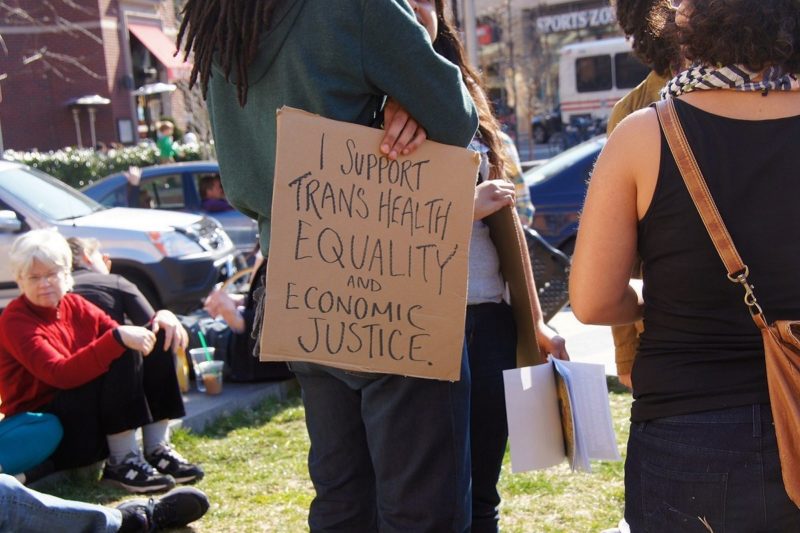Trans Activists and Allies Mark First International Trans Prisoner Day of Action
On Friday, January 22, trans people and their allies marked the first International Trans Prisoner Day of Action with solidarity events and letter-writing campaigns taking place all over the world, from Toronto to Vienna.

On Friday, January 22, trans people and their allies marked the first International Trans Prisoner Day of Action with solidarity events and letter-writing campaigns taking place all over the world, from Toronto to Vienna.
In the United States, where an estimated one in six transgender people have been incarcerated in their lifetime, the Day of Action generated events in more than a dozen states. These included the International Night of Liberation for Trans Prisoners in San Francisco, a “noise demo” in solidarity with incarcerated trans people in Minneapolis, and an evening of letter writing to trans prisoners in Philadelphia.
In a zine produced to mark the occasion, trans activists referred to the initiative as a “call to action against the system which seeks to erase our very existence,” adding that the survival of trans people and other sexual and gender minorities is not a “quaint conversation about awareness, but a struggle for us to live in a world determined to marginalize, dehumanise, and criminalise us—especially trans women, and especially Black, brown, and indigenous trans people.”
Designed to both interrupt the isolation that many trans people experience in prison and to shatter misinformation about trans communities, organizers called on supporters to write letters to inmates, host vigils, screen films, distribute literature, and hold workshops to share knowledge on trans experiences and “build strategies of resistance.”
The project is the brainchild of Marius Mason, a trans man who is currently serving a 22-year prison sentence in Fort Worth, Texas, for actions he undertook as a member of the Earth Liberation Front, a loose collective of radical environmental activists.
In a statement published on the Earth First! newswire, Mason wrote, “Sovereignty over our selves, our bodies, is essential for any other kind of liberty to be possible. By reaching out to trans prisoners, you affirm their right to define themselves for themselves—and defend them against the overwhelming voices who claim that they do not exist, that they must allow others to define them.”
A vicious cycle of poverty, unemployment, and homelessness channels trans people into prisons at a far higher rate than the general population. Roughly 49 percent of homeless respondents to the National Transgender Discrimination Survey reported experiencing incarceration at some point in their lives, a number that rises even higher for homeless transgender people of color. An estimated 47 percent of Black transgender people surveyed had experienced incarceration, compared to 16 percent of the trans population as a whole.
Trans people also face high rates of criminalization due to their overrepresentation in sectors like the commercial sex trade, as well as disproportionately high rates of substance dependence. An analysis of the National Transgender Discrimination Survey, which recorded the experiences of more than 6,400 transgender adults, revealed that over 10 percent of all respondents had engaged in sex work between 2008 and 2009, a number that shot up to 39.9 percent among Black respondents and 33.2 percent for those who identified as Hispanic or Latino/a.
Once they are locked up inside local, state or federal facilities, trans people are far more likely to experience abuse. Data from the Bureau of Justice suggests that 39.9 percent of transgender prison inmates, and over 26 percent of transgender jail inmates, were subjected to nonconsensual “sexual activity,” either with other inmates or staff members, in 2011-2012. According to the New York Times, trans inmates are abused at a rate that is “10 times higher” than that of the overall prison and jail populations.
Although trans people comprise just 1 percent of those held in immigration detention centers, three out of the 15 confirmed cases of sexual assault reported over a four-year period involved a trans victim, a report by the Government Accountability Office found.
And sexual violence is not the only form of abuse trans prisoners face on a daily basis. Under the guise of “protecting” them from other inmates, trans prisoners are often placed in solitary confinement, a practice that has been widely accepted as a form of psychological torture. While there is a dearth of reliable data on the number of trans prisoners who have experienced solitary confinement, a report by the Black and Pink collective titled Coming out of Concrete Closets, based on a survey of more than 1,000 inmates, found that an overwhelming majority of LGBTQ prisoners (85 percent) had been placed in solitary confinement at some point during their incarceration; anecdotal evidence suggests that many of these prisoners identify as trans.
Denying trans prisoners health care and health services is also a common practice in jails and prisons across the United States. The Black and Pink survey found that 44 percent of trans inmates had been denied access to hormones, and only 21 percent were granted underwear or other cosmetic needs matching their gender identity.
The International Day of Action comes on the heels of one of the bloodiest years in history for trans people, which saw the deaths of 22 trans women, primarily trans women of color.
